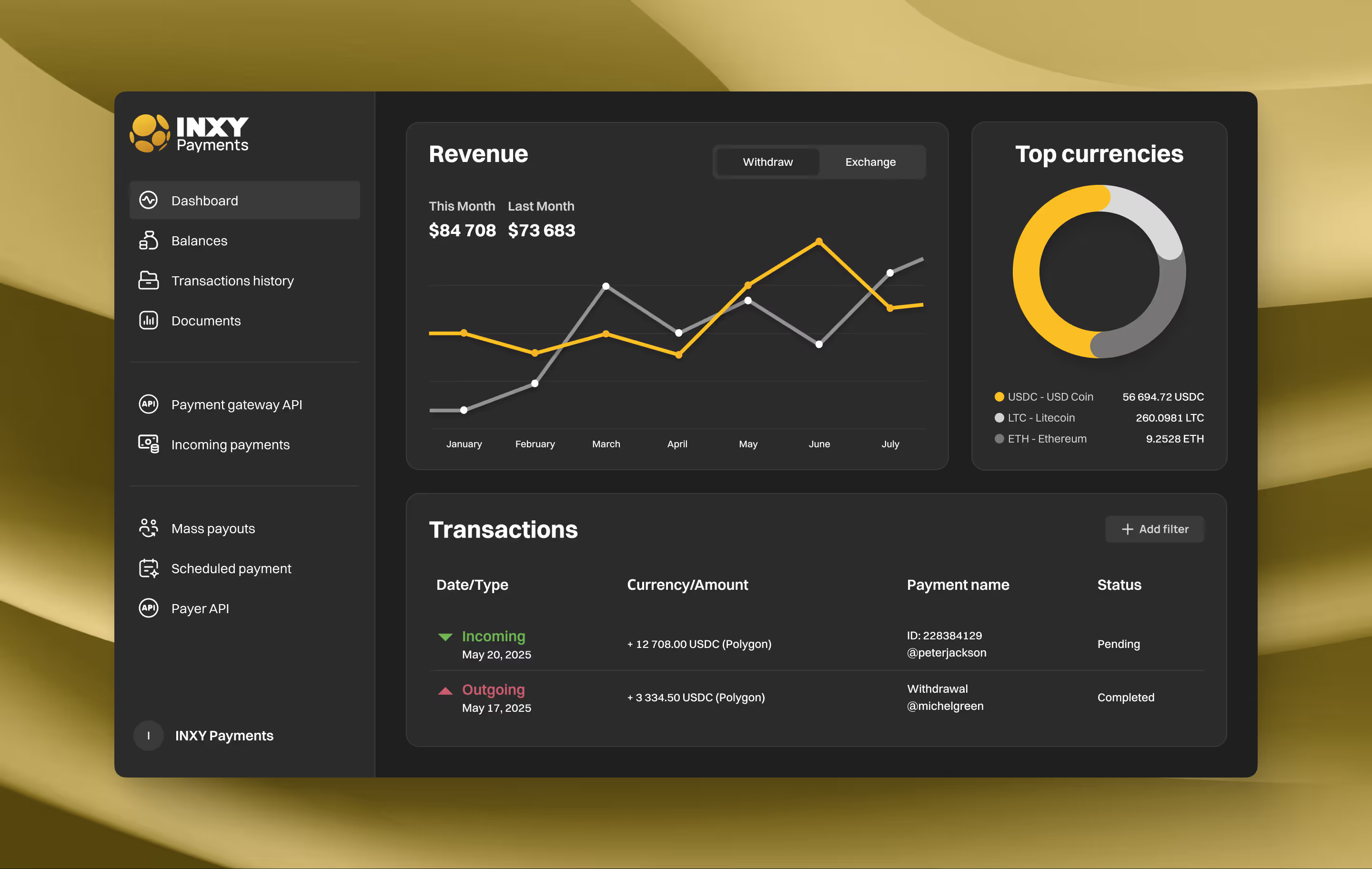Crypto Billing: Power Recurring & Global Settlements with Web3
Imagine sending an invoice late on Friday and seeing cleared USDC in your wallet before Monday morning—no banks, no FX mark‑ups, and no chargeback risk. That is the promise of crypto billing, and forward‑thinking SaaS, marketplace, and global e‑commerce brands outside the US/UK are already seizing the advantage.
In this guide you’ll learn why crypto billing is overtaking legacy rails, how to stay compliant across regions, and what to look for in a Web3‑ready partner like INXY Payments. Ready to see it live? Book a Demo.
[Suggested infographic: Crypto vs. fiat billing settlement times]
1. Crypto Billing: The New Standard for Global B2B Payments
1.1 Did You Know? Crypto Adoption in B2B (Hook & Market Context)
The Chainalysis 2024 Global Crypto Adoption Index shows that nearly 24 % of on‑chain volume in emerging markets is B2B. A 2024 Deloitte survey reports that 80 % of finance leaders plan to enable crypto billing by 2026. Momentum is real—and global.
1.2 Pain Points: Why Traditional Billing Slows You Down
- Cross‑border wires settle in days, not minutes.
- Card processing fees exceed 3 %, plus hidden FX spreads.
- Chargebacks drain revenue and frustrate finance teams.
- Banking holidays delay cash flow and hurt subscription renewals.
1.3 Preview: How Crypto Billing Solves the Challenge
Crypto billing delivers real‑time, 24 / 7, low‑cost settlement. Stablecoins such as USDC keep values predictable, while smart contracts automate recurring invoices and receipts.
2. What Is Crypto Billing?
2.1 Key Concepts: Crypto Invoicing vs. Fiat Invoicing
Fiat invoicing relies on ACH, SEPA, or SWIFT. Crypto invoicing bills in a digital asset—often a stablecoin—and settles almost instantly with finality built in.
2.2 How Crypto Payment Gateways Work
A gateway like INXY’s Crypto Gateway creates a unique address per invoice, watches the chain for confirmation, and credits your merchant balance. Funds can auto‑sweep to your treasury wallet or an exchange for same‑day conversion.
[Suggested visual: Flowchart of gateway‑based crypto invoice lifecycle]
3. Why Businesses Are Switching to Crypto Billing
3.1 Speed: Real‑Time & 24/7 Global Settlements
USDC on Polygon finalises in under two seconds—no more T+2 waits.
3.2 Lower Fees & Transparent Processing
On‑chain costs often run below USD 0.01, with zero interchange or scheme fees.
3.3 Eliminate Chargebacks & FX Risks
Transfers are irreversible at protocol level, and stablecoin billing removes currency swings.
3.4 Enhanced Security & Financial Inclusion
Cryptography secures each payment. Clients in card‑poor regions can pay directly from a self‑custody wallet.
3.5 Industry Stats & Market Data
- $157 billion in retail crypto inflows reached Indonesia in 2024 — Reuters citing Chainalysis.
- 77 % of merchants accept crypto primarily to cut fees—Deloitte.
- Stablecoin settlement volume grew 44 % YoY, per the March 2024 CCData Stablecoins Report.
4. Snapshot: Global Crypto Billing Compliance
4.1 EU: MiCA, GDPR & Local Trends
- MiCA passporting applies from December 2024—obtain or partner for a CASP licence.
- GDPR still governs personal data; expose hashes (not names) on public explorers.
4.2 Canada & APAC: Regulation & Real‑World Rollouts
- Canada’s Travel Rule triggers at CAD 1 000+ transfers.
- Singapore’s PSA now mandates segregation of customer funds.
4.3 LatAm: High‑Growth Use Cases
- Argentina and Brazil enable stablecoin payroll for inflation hedging.
- Chile’s Fintech Law opens the door for on‑chain invoices.
4.4 Key Industry Bodies to Watch (OECD, FATF)
The OECD shapes cross‑border crypto tax rules, while FATF updates Travel‑Rule guidance affecting VASP KYC.
[Suggested infographic: Regional compliance heat map]
5. How to Choose a Crypto Billing Provider
5.1 Evaluating Custody Models & Security
- Non‑custodial vs. omnibus custody—look for SOC 2 or ISO‑27001.
- Multi‑sig or MPC key management with optional withdrawal timelocks.
5.2 API Integration: Invoicing, Recurring Crypto Payments
Demand REST endpoints for creating, sending, and auto‑reconciling invoices plus rock‑solid webhooks for subscriptions.
5.3 Multi‑Chain & Stablecoin Support
Polygon, Solana, Tron, and Lightning keep fees low. Require USDC, USDT, and any local stablecoins.
5.4 Reporting, Reconciliation Tools, and Support
CSV/JSON exports, ERP connectors, and 24‑hour human support save finance teams hours.
6. Case Spotlight: INXY Payments
6.1 Client Scenario (SaaS/E‑commerce)
An EU SaaS platform selling into APAC faced week‑long SWIFT delays and 3 % card fees.
6.2 Results: Cost, Time, and Cash‑Flow Impact
- 70 % lower processing costs by routing 60 % of APAC invoices via USDC on Tron.
- Cash conversion cycle shrank from 10 days to same‑day.
- Chargebacks fell to zero.
7. Integration & Operational Best Practices
7.1 Setting Up Crypto Invoices & Payment Links
Create unique wallet addresses per invoice and embed QR codes in PDFs.
7.2 Managing Recurring Crypto Payments
Use smart‑contract pull payments or scheduled invoices with on‑chain approvals.
7.3 Exports & Reconciliation for Finance Teams
Map transaction hashes to invoice IDs and auto‑tag gas fees for tax deductions.
7.4 Data, Security, and GDPR Compliance
Hash all PII before anchoring proofs on‑chain, rotate keys, and monitor anomaly alerts.
[Suggested visual: Screenshot mock‑up of INXY reconciliation dashboard]
8. FAQ: Crypto Billing for B2B
8.1 How do I manage volatility?
Bill in USDC and auto‑convert to fiat within minutes through INXY’s OTC partners.
8.2 How does reconciliation work?
Our API returns a JSON receipt with the transaction hash and block height; export daily batches to your ERP.
8.3 Which cryptos do you support?
USDC, USDT, DAI, EURC, and regional stablecoins on Ethereum, Polygon, Tron, Solana, and Lightning.
8.4 How do we handle refunds?
Send a new outbound transfer to the customer’s wallet or offset against their next invoice; on‑chain funds are irreversible.
8.5 What about tax and reporting?
Stablecoin settlement counts as “in‑kind” payment in many jurisdictions—record fair‑market value at receipt; our CSV export includes USD equivalents.
8.6 Is this legal for my region?
Check local VASP licensing and Travel‑Rule thresholds. INXY maintains legal opinions across the EU, Canada, Singapore, and LatAm.
9. Ready to Modernize Your Billing?
9.1 Book a Demo with INXY Payments (CTA)
Leave legacy rails behind and supercharge cash flow with crypto billing.
Book a Demo with INXY Payments
This article is for informational purposes only and does not constitute legal or financial advice. Regulations evolve rapidly; verify requirements in your jurisdiction.


